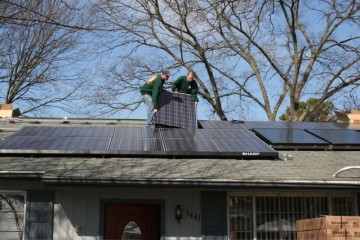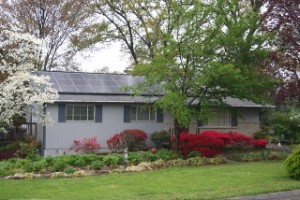SACE Executive Director Stephen Smith recently became the owner of the largest residential solar system in the Tennessee Valley Authority (TVA) region, covering his home with 36 198-watt Sharp solar photovoltaic (PV) modules. Read more to learn how to set up a residential solar system by following the Smith Family through the process.
 Step 1: Make an investment
Step 1: Make an investment
With a mix of new local and federal tax incentives, the Smith family decided it was the right time to make an investment in solar renovations. About six months later, the Smiths became fully dependent on solar energy; one of the biggest solutions to dirty energy consumption available in the 21st Century.
“Turning sunlight into electricity is part of the energy revolution I believe we need in this country and around the world,” said Smith. “Solar power is also a key part of the green economic stimulus that is going to fuel our nation’s recovery. My family is proud to part of this clean energy revolution.”
Step 2: Home Energy Rating
One of the first steps that the Smith family took was making energy efficiency adjustments to their home to help ensure that pricey energy was not being wasted. Homeowners have several different inspection and update options, one being the purchase of a home energy rating, which provides a standard, reliable measurement of a home’s energy efficiency.
“It’s important to first implement energy efficiency home renovations,” Smith said. “When you are quoted on a smaller, less expensive solar system to meet lower energy needs because of those efficiency renovations, you’ll be happy you made the investment.”
Step 3: Energy Efficiency Improvements
During the rating, home inspectors were able to recommend insulation solutions and determine alterations to air ducts and other air leaks needed throughout the home. In the end, the family saved 20 percent on their home energy bill because of the efficiency improvements.
Step 4: Solar Lighting
Following these efficiency changes, they determined that solar tubes were needed to bring natural light into dark hallways and rooms rather than installing energy-demanding light fixtures. Seven 160 DS passive-solar tubular day lighting devices were installed in the roof, reflecting natural light into the home. At a few hundred bucks, these economical devices are an option for most residential homes, and their pleasing, natural white light is often preferred in comparison to the normal light bulb glare. Click here to watch a video of the Solatube installation at the Smith’s home.
Step 5: Solar Hot Water System
When looking at an overview of electricity production for a home, the hot water system can become a drain on bills. The Smiths decided to purchase a Schuco Slim Line Domestic Hot Water System. The two panels they chose are roughly two inches thick, and were nicely installed, lining up with the other solar PV panels.
A solar hot water system can be one of the most efficient ways of using solar energy. And because solar radiation can be immensely powerful, the energy produced by sunshine on one square foot of roof in one year is predicted to be equal to 2.5 gallons of oil. On a cloudy winter day, two or three collectors can supply enough hot water for an average family.
Step 6: Give back to the Grid
Since the Smiths made their transition to solar power dependence, they are producing more power than their house demands, giving them an opportunity to sell that energy back to the local utility, the Tennessee Valley Authority. With the purchase of a Sunny Boy 700US inverter, the system is grid-tied, and data is collected and accessible online, showing the amount of energy historically produced by the system.
“I enjoy watching the meter move backward,” Smith said. “At any point in the day I can actually go online and see how much energy is being produced. That has been a very rewarding aspect of this whole transition.”
Conclusion
 With so many solar options and incentives, there’s never been a better time for residents in the Southeast to start taking advantage of solar energy. With renewable energy technologies quickly becoming cost-competitive with conventional forms of power, average citizens have an opportunity to transition from reliance on their local community grid to their own homegrown energy production system.
With so many solar options and incentives, there’s never been a better time for residents in the Southeast to start taking advantage of solar energy. With renewable energy technologies quickly becoming cost-competitive with conventional forms of power, average citizens have an opportunity to transition from reliance on their local community grid to their own homegrown energy production system.
While the origins of energy become an increasing hazard and the impacts of global warming are being felt directly in areas across the Southeast, residents are looking for ways to safely secure their power needs. The cradle-to-grave impacts of oil sands processing and coal mining are devastating to environmental conservation efforts. But as these processes function at such high level capacity, lessening the community “environmental footprint” can seem overwhelming.
“Breaking it down, and looking directly at our homes can be one of the most successful ways to effect environmental change and contribute to the solution,” said Smith. “As an organization, we try to consistently point out ways that residents can make a personal lifestyle adjustment to alter the overall energy production cycle. Solar energy is one of those options; it’s a positive way that people can rely a little more on renewable energy.”
Resources
Blog: Smith Family Solar Home by Dr. Stephen A. Smith
TVA Generation Partners Program
Solar America Cities Program
City of Knoxville, Solar America City
SACE – Lean About Solar
How to Renovate Your Home for Energy Efficiency